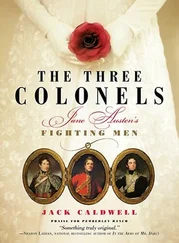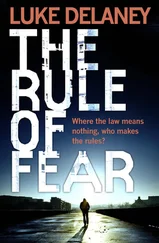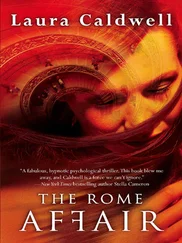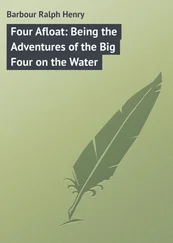We wouldn't be standing here.
He takes it as a throwaway at first, then realizes what I mean. Without Curry and McBee and The Belladonna Document , Paul and I would never have met. We would've crossed paths on campus the same way Carrie and I just did, saying hello, wondering where we'd seen each other before, thinking in a distant way what a shame it was that four years had passed and there were still so many unfamiliar faces.
Sometimes, he says, I ask myself, why did I have to meet Vincent?
Why did I have to meet Bill? Why do I always have to take the long way to get where I'm going?
What do you mean?
Did you notice how the portmaster's directions don't get straight to the point, either? Four south, ten east, two north, six west. They move in a big circle. You almost end up where you started.
Finally I understand the connection: the wide sweep of circumstance, the way his journey with the Hypnerotomachia has wound through time and place, from two friends at Princeton in my father's day, to three men in New York, to a father and son in Italy, and back now to another two friends at Princeton-it all resembles Colonna's strange riddle, the directions that curl back on themselves.
Don't you think it makes sense that your father is the one that got me started on the Hypnerotomachia '' Paul asks.
We arrive at the entrance, and Paul opens the library door for me, as we duck in from the snow. We are in the old heart of campus now, a place made of stones. On summer days, when cars streak by with their windows down and their radios up, and the whole student body wears shorts and T-shirts, buildings like Firestone and the chapel and Nassau Hall seem like caves in a metropolis. But when the temperature drops and the snow falls, no place is more reassuring.
Last night I started thinking, Paul continues, Francesco's friends helped him design the riddles, right? Now our friends are helping to solve them. You figured out the first one. Katie answered the second one. Charlie knew die last one. Your dad discovered The Belladonna Document . Richard found the diary.
We pause at the turnstile, flashing our campus IDs to the guards at the gate. As we wait for the elevator to C-floor, all the way at the bottom, Paul points to a metal plate on the elevator door. There's a symbol engraved on it that I've never noticed before.
The Aldine Press, I say, recognizing it from my father's old office at home.
Colonna's printer, Aldus Manutius, took his famous dolphin and anchor emblem, one of the most famous in printing history, from the Hypnerotomachia .
Paul nods, and I sense this is part of his point. Everywhere he's turned, in this four-year spiral back toward the beginning, he's felt a hand at his back. His whole world, even in the silent details, has been nudging him on, helping him to crack Colonna's book.
The elevator doors open, and we step in.
Anyway, I was thinking about all that last night, he says, pressing the button for C-floor as we begin our descent. About how everything seemed to be coming full circle. And it hit me.
A bell dings above our heads, and the doors open onto the bleakest landscape of the library, dozens of feet underground. The ceiling-high bookshelves of C-floor are so tightly packed that they seem designed to shoulder the weight of the five floors above us. 1b our left is Microform Services, the dark grotto where professors and grad students huddle in clusters of microfilm machines, squinting at panels of light. Paul begins leading me through the stacks, running his finger along the dusty spines of books as we pass them. I realize he's taking me to his carrel.
There's a reason everything returns to where it started in this book. Beginnings are the key to the Hypnerotomachia . The first letter of every chapter creates the acrostic about Fra Francesco Colonna. The first letters of the architectural terms spell out the first riddle. It's not a coincidence that Francesco made everything come back to beginnings.
In the distance I can see the long rows of green metallic doors, spaced almost as closely as high school lockers. The rooms they guard are no bigger than closets. But hundreds of seniors shut themselves inside for weeks on end to write their theses in peace. Paul's carrel, which I haven't seen in months, sits near the farthest corner.
Maybe I was just getting tired, but I thought, what if he knew exactly what he was doing? What if you could figure out how to decipher the second half of the book by focusing on something in the very first riddle? Francesco said he didn't leave any solutions, but he didn't say he left no hints. And I had the directions from the portmaster's diary to help me.
We arrive in front of his carrel, and he begins to twist the combination lock on the door. A sheet of black construction paper has been taped to the little rectangular window, making it impossible to see inside.
I thought the directions had to be about a physical location. How to get from a stadium to a crypt, measured in stadia. Even the portmaster thought the directions were geographical. He shakes his head. I wasn't thinking like Francesco.
Paul opens the lock and swings the door wide. The little room is filled with books, piles upon piles of them, a tiny version of the President's Room at Ivy. Food wrappers litter the floor. Sheets of paper are taped to the walls, thick as feathers, each one scrawled with a message. Phineus son of Belus wasn't Pbineus king of Saknydessus , says one. Check Hesiod: Hesperethousa or Hesperia and Arethousa? says another. Buy more crackers, says a third.
I lift a stack of photocopies from one of the two chairs crammed into the carrel, and try to sit down without knocking anything over.
So I came back to the riddles, he says. What was the first riddle about?
Moses. The Latin word for horns.
Right. He turns his back to me to shut die door behind us. It was about a mistranslation. Philology, historical linguistics. It was about language .
He begins searching through a column of books atop the hutch of his desk. Finally he finds what he wants: Hartt's History of Renaissance Art.
Why did we get lucky with the first riddle? he says.
Because I had that dream.
No, he says, finding the page with Michelangelo's sculpture of Moses, the picture that began our partnership. We got lucky because the riddle was about something verbal, and we were looking for something physical. Francesco didn't care about actual, physical horns; he cared about a word, a mistranslation. We got lucky because that mistranslation eventually manifested itself physically. Michelangelo carved his Moses with horns, and you remembered that. If it hadn't been for the physical manifestation, we would never have found the linguistic answer. But that was the key: the words .
So you looked for a linguistic representation of the directions.
Exactly. North, south, east, and west aren't physical clues. They're verbal ones. When I looked at the second half of the book, I knew I was right. The word stadia shows up near the beginning of the very first chapter. Look, he says, finding a sheet of paper where he's worked something out.
There are three sentences written on the page: Gil and Charlie go to the stadium to watch Princeton vs. Harvard. Tom waits as Paul catches up. Katie takes photographs while winsomely smiling and mouthing, I love you, Tom.
Winsomely? I say.
Doesn't look like much, right? It just sort of rambles, like Poliphilo's story. But plot it out in a grid, he says, turning the piece of paper over. And you get this:
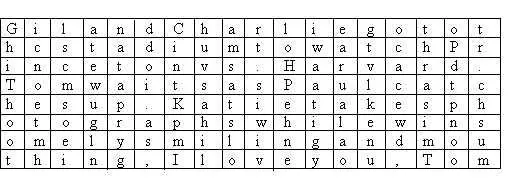
I'm waiting for something to jump out at me, but it doesn't.
Читать дальше




